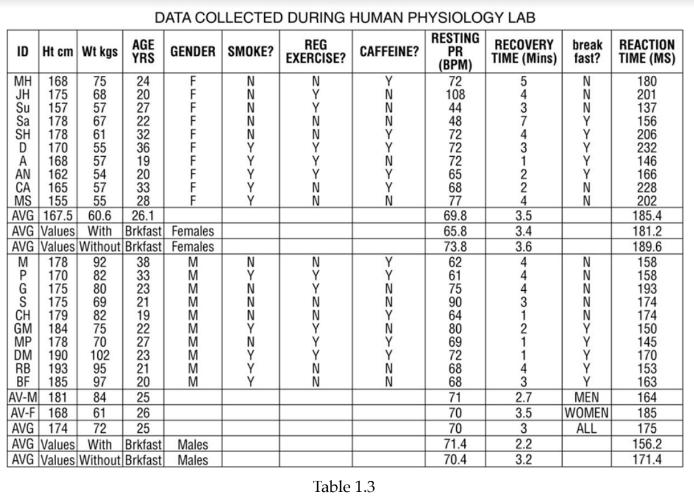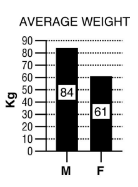Following is a table of data collected from one section of an 8 A.M. physiology lab. There were 20 students present, 10 men and 10 women. Information collected from the students included their height, weight, age, and resting pulse rate. In addition, the students were surveyed to see if they smoked cigarettes, considered themselves "regular exercisers," if they had consumed caffeine the morning
of the lab, and if they had eaten breakfast that day. A "y" or "n" (yes or no) was recorded to indicate their answers. Each student did "jumping jacks" for 5 minutes and recorded the time required to regain their resting heart rate, which is listed on the table as "recovery time." Finally, each student participated in an exercise designed to measure their reaction time (in milliseconds) in catching an object dropped by a lab partner according to specified criteria. Use this table to answer the following questions. Ignore statistical problems caused by small sample size, and so on.
You are doing an experiment to determine if caffeine consumption affects reaction time.
A. Which is the dependent variable?
B. Which is the independent variable?
C. Briefly describe some ways you might manipulate the independent variable.
D. Name three stimuli you could use, and how you might measure reaction time for each.
E. Write an appropriate hypothesis for this study.
F. You compute the following average values from your experiment. What would be a logical conclusion for
these data?
Average caffeine consumer's reaction time: 400 ms
Average noncaffeine consumer's reaction time: 650 ms
G. Sketch a simple graph to convey these results to your classmates. What kind of graph did you choose?
Why? Which variable did you plot on the x-axis? Which one did you plot on the y-axis? Why?
H. Do the results of this experiment support the hypothesis you chose?


A. Reaction time
B. Caffeine consumption
C. Vary the amounts of caffeine consumed; vary the source, for example, use coffee, pills, cola drinks, and/or
chocolate; vary both the amounts and sources.
D. Answers will vary. Example: a computer-based timer could measure the time elapsed between the subject's
detecting the appearance of an object on the computer monitor and depressing a key on the keyboard. Auditory or
touch stimuli could be used, too.
E. Depending on the answer to C, could choose: "Consumption of caffeine decreases reaction time" or similar
statement.
F. Consumption of caffeine improves reaction time by 250 ms, on average.
G. Bar graph; allows comparison of the average of two groups. The x-axis: group, caffeine or none. The y-axis:
reaction time in milliseconds.
H. Yes, in case of hypothesis written in D.
You might also like to view...
Hormones are chemicals that circulate in the bloodstream.
Answer the following statement true (T) or false (F)
All of the following provide chemoreceptor input to the respiratory centers of the medulla oblongata except the
A) olfactory epithelium. B) medullary chemoreceptors. C) aortic body. D) carotid body. E) central chemoreceptors.
Answer the following statement(s) true (T) or false (F)
1. Most neurons have multiple dendrites. 2. Unipolar neurons have only a single process leading away from the soma. 3. Oligodendrocytes serve the same purpose in the CNS that satellite cells do in the PNS. 4. Ependymal cells line the inner cavities of the CNS.
The thymus is important for:
A. T lymphocyte maturation. B. removal of foreign antigens. C. B lymphocyte maturation. D. secretion of hormones that promote B lymphocyte immunocompetence.